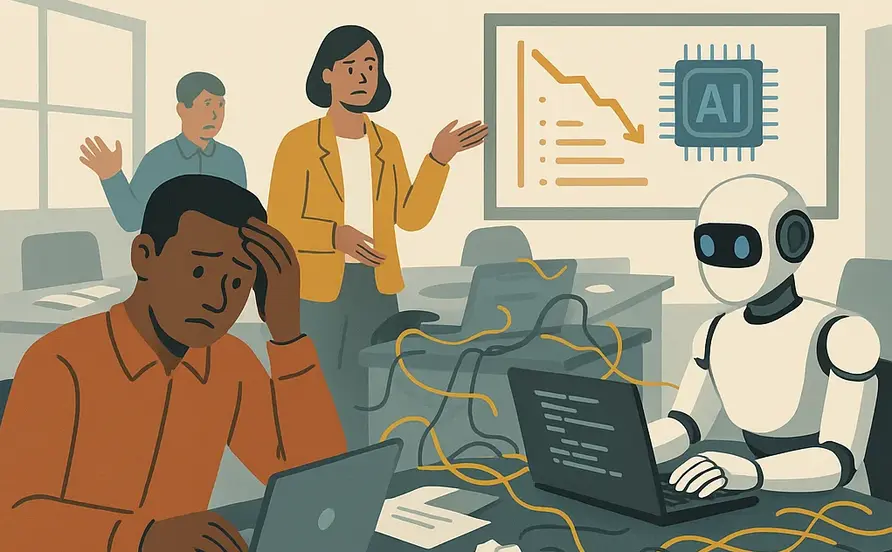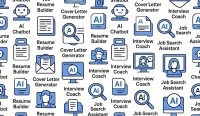Hundreds of billions of dollars are being spent automating workplaces with artificial intelligence. This amazing technology promises productivity-enhancing gains across every industry. Over 75% of businesses worldwide are using generative AI in at least one function. AI now accounts for 40% of US GDP growth this year. Yet despite this staggering investment and adoption, we’re entering a messy rollout phase where companies are struggling to realize promised returns.
At the Charter Workplace Summit in New York, senior leaders from America’s biggest companies gathered to discuss AI implementation challenges. These are the people tasked with rolling out AI and preparing workforces for future skills needs. What emerged from off-the-record discussions, panels, and big-picture sessions is that there’s no clear path forward for GenAI at work—it’s all still being decided.
The Deployment Gap
While massive investment has flowed into AI infrastructure and tools, actual workplace adoption remains in very early days. Roughly 10% of companies are fully integrating AI into their processes, but widespread deployment will take years to unfold. The challenge isn’t the technology itself—which continues advancing at breakneck speed with new models dropping every six months—but figuring out exactly how to use it and where it makes sense.
A study by MIT Media Lab found that 95% of GenAI pilots in workplaces failed. This failure rate suggests organizations are struggling to translate AI potential into practical workplace applications that deliver measurable productivity gains. The promise exists, but execution remains problematic.
The Earnings Report vs. Reality Gap
The Financial Times conducted a massive analysis examining S&P 500 companies’ earnings reports and regulatory filings to understand actual AI usage versus hype. The results revealed a significant disconnect between public statements and documented reality.
In earnings calls, CEOs consistently rave about AI being amazing, bringing incredible productivity gains, and creating a Cambrian explosion of innovation. These optimistic public statements contrast sharply with regulatory filings, which tend to be more measured and risk-averse. In those filings, risks outweighed benefits very clearly, with few concrete examples of actual AI usage.
AI references in filings are often abstract, talking about productivity without offering concrete examples of implementation. Coca-Cola exemplifies this disconnect. In earnings reports, Coca-Cola raved about using generative AI to transform their business. But in regulatory filings, the only example they could provide was using generative AI to create a Christmas advertisement—hardly a transformative application.
The Two-Speed Adoption Problem
Companies are adopting AI at two dramatically different speeds. Tech companies like those on the S&P 500 have progressed far enough that they think of AI agents as co-workers. The seven big tech companies driving S&P 500 growth are deeply integrating AI into their operations and product development.
Meanwhile, many traditional companies are still trying to get employees to use ChatGPT or Claude. These organizations are struggling to understand what AI adoption even means, and most haven’t seen productivity gains yet. The gap between these two extremes reveals how unevenly AI transformation is occurring across the economy.
While the S&P 500 index is rising, much of that growth is driven by those seven tech companies. Other S&P 500 companies haven’t necessarily grown significantly despite claiming AI usage, suggesting their adoption remains more aspirational than actual.
The Training Crisis
The biggest problem facing AI rollouts is the training gap. Companies are spending enormous sums on AI technology but not investing proportionally in teaching people how to use it effectively. Most people with AI access are equivalent to having an iPhone and only using it to send text messages and make phone calls—missing vast capabilities.
Multiverse, an AI upskilling platform, sees this training gap as the fundamental barrier. They’ve demonstrated that properly trained teams achieve substantial results: accounts teams processing invoices 50% faster with half the errors, software engineering teams shipping code 75% faster. These tangible gains are possible, but require training investment.
The challenge is that traditional software rollouts assumed adoption would follow naturally over several years. AI is different because its inherent capability is so much greater, requiring fundamental workflow changes. The amounts being spent are also dramatically higher, raising stakes. People spending most on AI won’t win—people with the most AI-enabled workforces will.
The Shadow Use Problem
What you often see in organizations are shadow use cases where official corporate AI initiatives remain untouched or unused while employees just use their preferred AI tools. This happens because there’s insufficient communication between leadership and staff about what people need and which tools they actually want.
The problem with shadow use is that workplaces have different rules than personal usage. Corporate environments contain sensitive information where accuracy matters critically. These models can make factual mistakes that could be embarrassing or catastrophic for organizations. Every organization needs to think about how AI tools apply to them and what employees need to know about proper usage.
The Shadow Use Problem
In many organizations, employees bypass official AI tools for the ones they prefer — creating hidden workflows and unseen risks. Without alignment between leadership and staff, shadow AI undermines data security, accuracy, and trust. The future of enterprise AI depends on education, governance, and the right balance between innovation and compliance.
Explore AI Governance & Compliance Roles →The Leader’s Dilemma
Leaders are struggling with AI deployment because they’re operating in unfamiliar territory. For leaders, being comfortable with failure is something not generally taught in business school. Failure is something executives are allergic to encouraging in their workers. Yet the AI rollout period requires experimentation and possibly failure to discover effective use cases.
The central question leaders face: will businesses see return on investment? With such high stakes and massive spending, the pressure to demonstrate results is intense. But we’re still in early deployment days—AI was still in the lab just a few years ago. We have to be patient, but the question remains how long to wait and whether gains will come sooner rather than later.
What Makes AI Different
Previous technology adoptions required learning about the technology over time. AI is different because you must use it and do it daily. You need daily practice to make it a regular work habit. This requires intrinsic interest from individuals to see value in day-to-day professional applications, while employers must deliver availability and consumption of training resources.
The best advice for anyone wanting to improve AI usage in their job is learning to prompt effectively. Understanding audience, goals, context, and reference materials enables getting desired outputs that make AI a regular, efficient habit. Interestingly, journalists make excellent prompters because they’re good at asking questions and understanding audiences.
The Cisco Example
Cisco demonstrates how tech companies are integrating AI broadly across operations. Internally, Cisco uses AI across product development—the Webex platform has AI agents built in that make operations easier and more efficient. Cisco provides various AI platforms for employees, though adoption levels vary from super proficient to still getting to grips with usage.
For Cisco, the key is adoption becoming part of employees’ DNA and daily operations. Sarah Walker, Cisco’s UK and Ireland CEO, emphasizes leading by example: teams won’t adopt platforms unless leadership talks about them and uses them consistently. Cisco conducted masterclass sessions with senior leadership teams, speaking positively about the workforce-AI partnership rather than replacement fears.
The Inevitable Shakeout
Everyone feels behind the curve on AI adoption, creating a desire to do more faster without necessarily understanding what works. Currently, the assumption is that this will work and lead to amazing future results. But if AI proves to be a massive bubble that bursts, only use cases that actually work and bring employee benefits will survive. Everything else won’t make it through the shakeout.
Different business needs mean no one-size-fits-all solution. Businesses need staff input while staff need leader support and training to realize financial and productivity gains AI promises. We’re at a similar stage to internet rollout in the mid-1990s—early in the cycle with boom and bust to come, bringing disruption but also excitement at work.
Frequently Asked Questions
Q: How widespread is AI adoption in workplaces?
A: Over 75% of businesses worldwide use generative AI in at least one function, but only 10% of companies are fully integrating AI into processes. MIT Media Lab found 95% of workplace GenAI pilots fail, indicating significant adoption challenges.
Q: Why are companies struggling with AI adoption despite massive investment?
A: Companies are spending enormous sums on AI technology without investing proportionally in training. Most users are like having an iPhone and only using it for calls and texts—missing vast capabilities. The training gap prevents realizing AI potential.
Q: What’s the difference between how companies talk about AI publicly versus reality?
A: Earnings calls feature CEOs raving about AI bringing productivity gains and innovation. But regulatory filings show risks outweighing benefits with abstract mentions of productivity but few concrete examples—suggesting more aspirational than actual adoption.
Q: What are shadow use cases and why are they problematic?
A: Shadow use occurs when employees ignore official corporate AI tools and use personal AI tools instead. This is dangerous because workplaces contain sensitive information where AI factual mistakes could be embarrassing or catastrophic, requiring proper organizational control.
Q: Why does AI require different training than previous technology?
A: AI isn’t about learning about the technology—you must use it daily and practice regularly. This requires intrinsic interest from individuals seeing value in day-to-day applications combined with employers delivering training and making resources available for consumption.
Q: Will businesses see return on AI investment?
A: The jury remains out. Only use cases that actually work and bring benefits to employees will survive any potential AI bubble. Companies with most AI investment won’t necessarily win—those with most AI-enabled workforces will, requiring training rather than just technology deployment.




